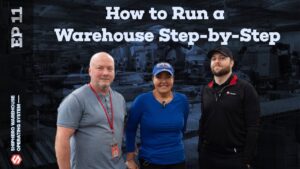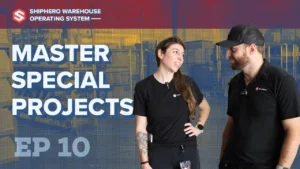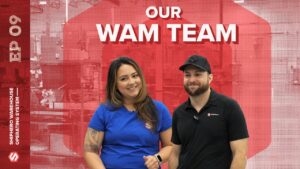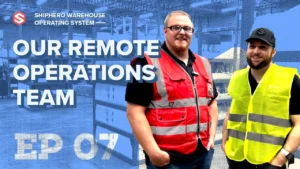Video Transcript
You're going to be given challenges every
day out in warehousing, and warehousing is
never going to be perfect no matter what you
try to do.
And so, just being able to adapt and to learn
from the failures and the wins that you acquire
through the years is what's going to help.
You want to be able to have all the negativity
just bounce off of you and just grow from it.
Hey, I am here today with Logan Bates, the
GM of our Jacksonville facility.
We're going to talk about how to run a warehouse
really, really well.
And, Logan's an excellent warehouse manager.
So Logan, first off, how old are you?
26 years old.
And, you have how many people reporting to
you?
About 60, 61, 62.
So, that's pretty impressive.
So, can you talk us through how you started
in this business, and how you got to where
you are today running the whole building?
So, I started seven years ago.
19, ripe old age-
19 years old-
... of 19-
Yes sir.
I worked with Rob.
Rob helped mentor and develop me and just
helped me learn the whole logistics side of
it and the Ecommerce side.
And then, we got into the fulfillment.
He had a couple buddies that he knew through
his Masterminds and then we brought them in
as clients, and we started fulfilling for
them.
So, that's it.
That's basically you only job you've ever
had is running a warehouse with Rob?
Yes, sir.
Started it with Rob and then we started using
ShipHero in 2016.
And ever since 2016, we've just been learning
the WMS.
Yeah.
I think you guys were number one.
Or, you were, if not the first 3PL within
the first three months of us offering 3PL,
providing our SaaS product to 3PL, before
that was just brands.
So, thank you for that, appreciate that.
Yes, sir.
You guys help us along.
So running 60 people, that's a lot.
What are the challenges?
What's the hardest part about running this
building and running the people in this building?
The first part of it was the learning side,
and that was the personalities.
Dealing with different personalities and people
from different cultures, you take in a lot,
and it's wonderful because you get to meet
new people.
You get to work with new people.
Everyone has a different story, and everyone
has a different place where they come from.
My favorite was a lot of the people who come
in from the foreign countries.
We had a couple that came from Cameroon, a
couple from the South America-
I remember that.
French speaking, right?
Yes, sir.
And so, we like to take on the challenge of
learning the different languages and stuff
like that.
And inside the warehouse, especially in the
fulfillments, it's kind of easy.
You learn certain aspects, the totes or carts
or just everything gets repetitive, but then
you start learning it in their language and
easier ways to communicate with them.
But, I like to take on that challenge.
You never know what someone's going through
at the end of the day, and they also help
you develop as a person as you can help develop
them when they come into the United States.
Yeah, no, it's super rewarding, and I think
you've done a really good job of it in this
building.
Yeah, so that was the first part was just
dealing with the personalities and then came
to the workloads.
You want to run it lean.
You want to be a lean warehouse and so you
want to make everything as efficient as you
can.
And so, early on ShipHero offered that with
the many features in the beginning was like
bulk shipping, picking.
We were picking, before we were using ShipStation,
you're picking off a sheet of paper and such.
And now, we moved on and we're now using electronic
picking.
And so, the efficiencies have gotten better.
And then as we grew, the ship yard, WMS grew
and so we started to be molded by the system
itself.
Yeah, you guys did a great job of using the
process and helping us frankly refine the
process of how we build the software to...
Because if the software doesn't match the
process, we all know it doesn't work.
Let's talk some more about what you think
about as the GM of the building.
So, I'm going to guess it's six letters.
C-P-P-S-L-A.
Yes.
Is that-
Yes.
Explain what that means.
This is the main...
The CPP is going to be like your cost for
a package.
That's going to be your labor divided by the
amount of packages we're shipping out.
And so, we want to maintain the lowest number
that we can while also meeting that SLA.
So, there's a perfect merriment between the
CPP and the SLA itself.
You don't want to make your CPP go so high
to where you're missing or you're hitting
the SLAs and your CPP go super high.
But, you also don't want to miss SLA and then
your CPP is super low.
And so, you want to try to tie everything
in and just have the perfect merriment between
the two.
And, how does utilizing temps as well as,
I know we do a lot of temp to hire in this
building.
How do you use that to help you hit your SLAs
while managing your CPP in a business where
we all know it's not flat all year, right?
Q4, when we have big customers that have big
drops, demand can double or more.
So, how do you think about managing your labor
in what we all know is a pretty dynamic industry?
Yeah, you could never really hit the projected
values right on top of the head, but you can
always have an educated guess.
And so, bringing in the temps gives you that
flexibility.
Our heaviest days are going into our Mondays
and Tuesdays and so that's when you want to
bring in, you look for the temp side.
You bring them in for a day or two, then you
can kind of move on from them as you need
them.
You can also do the daily temps where you
can just bring in temps for a certain day
and then you don't have to bring them back
again.
The daily temps are helpful for during peak
season.
When you're going into peaks, you want to
have that dynamic.
So if you have a lot of callouts or someone
who is not here or you need more help, like
unloading trucks, that's where you'll go into
and grab the daily temps.
And, I assume daily temps, you're not training
them how to pick pack, replan.
You're probably giving it more tasks that
are less computer oriented, right?
What are the tasks you would typically give-
Correct-
... to a day temp?
So, your day temps are going to be more your
manual labor, lifting up the boxes, unloading
the truck, moving of the pallets, or even
just picking up garbage around the warehouse,
boxes, helping the packers out.
Basically, where they can help everyone run
more efficiently.
And then, when you're thinking about how many
people you need, I know we run multiple shifts,
so what are the shifts we run, and how do
you staff those different shifts?
So currently, we're running three shifts.
Our first shift is going to be a 7:00 to 3:30.
That's Monday through Friday.
Our second one is going to be a 3:30 to 12:00,
Monday through Friday.
And then, our third shift is our weekend.
Our weekend is now going to four days during
peak season, which is going to be a 7:00 to
5:30 shift.
And so, is that a 4/10, 4 days a week-
It's going to be four days a week.
It's going to be Saturday, Sunday, Monday
and Tuesday.
So, you're going to try to hit the heaviest
days of them all.
Got it.
Yeah, the four tens, if you can make it work,
it's always helpful because you get the labor
when you need it and then people get that
40 hours.
Some people really like the 4/10.
So, let's walk a bit, and let's talk about
night shift and then how you decide what work
happens when dealing with replan, dealing
with fixing inventory issues.
So, our night shift is going to be a little
bit built up with more of our inventory team
and our problem solving team.
Like I said earlier, the first shift was more
based on the outbound.
And so, your second shift is going to do more
of your cleanup of your SLA orders or anything
that is kind of straggling along, need a little
bit more extra problem solving as well as
getting your replan for the next day.
And so, we focus a lot on the inventory in
the evening shift.
So when we come in the mornings, we're ready
to rock and roll and start hitting the orders
from the start.
So if someone's thinking about scaling up
their warehouse, growing their team, when
should they think about adding second shift,
if they only have one shift right now?
I think it's going to come down to where your
daily volume is.
If you get to a point where your daily volume,
it's exceeding your team size, and you're
missing a little bit on that SLA.
The SLA is what you promised to the clients,
and you're making sure that the orders are
getting out in a timely manner.
And so, if you have stragglers or orders that
are still sitting and waiting, coming in the
following morning, that's kind of when you
want to start looking into that second shift
or replan.
You don't want slow starts in the morning.
You want to come in, you want to rock and
roll because that first hour, first hour or
two of your shift is what's going to make
that shipping day.
Right.
Okay.
And, we probably pay more for weekend or second
shift hourly than we do-
Correct, yes sir.
So, what's the reason we don't just put 20
more people on the day shift at the lower
price versus adding a night or a weekend shift?
What's the advantage that pays for itself
on adding that night and weekend shift?
Management.
You add X amount of people to a shift, you
want to be able to manage them properly.
But, you don't want to have to bring in extra
managers to dedicate them to running that
first shift.
And so, when you're doing nights, you do pay
a little bit more of a premium, but there's
a little bit less going on.
And so, you're able to more focus on one or
two things.
So if you want to focus on the replan, then
you can spend that time working on replenishment.
You're not really worried about hitting that
SLA or getting the orders out the door because
the trucks have already left.
Right.
So it's more focused and more you're not stepping
on top of each other.
Correct.
Replan has a little more time, a little more
space when there's not 50 other people in
the building?
Correct.
You can be a little bit more detailed.
Basically, you get into the ins and outs of
certain items that you wouldn't be able to
tackle during the day with all the chaos.
And then, this building's about 130,000 square
feet.
What equipment do we have in terms of forklifts,
turret trucks, ePickers?
So currently right now, we have a turret truck.
We also have a ePicker, which is just a man-up
with no pallet behind it or anything like
that.
And then, we also use a order picker.
The order picker is the one where you're going
to have the pallet behind you, and it's a
man-up system, so you can go up to the higher
parts of the racking and grab your items and
place it on the pallet with you.
The pallet travels with you compared to the
ePicker.
And then, we also have a counterbalanced forklift.
And, which one do you use for replan?
Re-plan, currently we're using the ePicker.
We also use the order picker.
Now, when it comes to our bulk quarters or
our bulk items, we will use the turret truck.
The turret truck can fit down a 76-inch aisle.
Right, okay.
Yeah, so it's good for the very narrow aisles.
So, when you have a, let's say, a bulk pull
and then you also have replan, have wholesale,
is there a different operator dedicated to
each of those tasks or do you have the same
operator gets the different QR codes and has
different tasks?
This is a wholesale pull.
This is a bulk pull.
So, we have the same operator.
The same operators will do all the tasks,
but we also have backup operators just in
case we need a little bit more help in that
area.
But usually, we do run the same operators
that just bounce between all the tasks basically.
And then, 2023 has been a really good year.
What lessons have you learned to help run
this building really well?
Just being able to adapt and improvise.
You're going to be given challenges every
day out in warehousing, and warehousing is
never going to be perfect no matter what you
try to do.
And so, just being able to adapt and to learn
from the failures and the wins that you acquire
through the years is what's going to help.
You want to be able to have all the negativity
just bounce off of you and just grow from
it.
Yeah, JB Sauceda says, "We're in the exception
handling business," so if you take every issue
too personally, you let it bother you too
much, take it home with you, it's a really
tough business.
Because, we're only here to fix problems.
If we didn't have problems, we wouldn't need
managers.
So yeah, it could be a mentally health challenging
business sometimes because there's a lot happening
with a lot of time pressure and cost pressure.
That really makes a lot of sense to me.
Let's change gears.
What's your favorite feature or favorite part
of the ShipHero, WMS?
So, I have a couple, well, I think one of
the major ones is going to be bulk shipping.
Bulk shipping is super profitable and super
efficient if you're inside the warehouse.
You have a customer that runs the sale, and
they're doing a big sale on let's just say
phone charges or phone cases, and they have
a thousand orders come in.
There's a high possibility that those a thousand
orders could be all bulk shipped at one time.
And so, you have it picked by one person.
You can also then use QR code picking for
the batches.
And so, you go to the location, scan the product,
grab it, take it back to the packer and then
one person can pack it.
The other one would be single item batches.
I think single item batches, I think it's
a little underrated, but I think it's actually
super useful and efficient inside the warehouse.
So after you get done with your bulk shipments,
you want to run into the single item batches.
Your single item batches are going to grab
all those onesie, twosies that don't have
enough to bulk ship.
They have enough for a pecker to go down and
actually pick them efficiently and take them
straight to the packer.
And then once you get to the packer, the packer
then has the option if they want to bulk ship
just five of those or three of those and then
you can move on to the next SKU.
Yeah, so little note fact, the only, when
we launched ShipHero, it was to have single
item batch.
Single item batch was the original idea behind
ShipHero.
So, in the warehouse that Josef and I, Josef,
our VP of product, that I had, we had flash
sales, so we would sell one deal a day, and
we sold martial arts uniform for a martial
art called Brazilian Jiu Jitsu.
Most people ordered one uniform.
So, single item batch allowed us to reduce
our pick and pack labor by 40% just by adding
that feature and that was the only feature
other than single order that we had at launch.
A lot of people don't get it.
They don't grok why it's useful.
But yeah, for me it's bulk and then single,
then multi.
And, I wish more people would see the value
in it.
If you track your CPP, you'll see you drive
it down a lot by using single item batch and
pickers love it because they just fill up
a cart.
They just grab stuff.
It's super fast and rewarding.
So, I'm glad you liked that.
I'm glad you liked that feature.
I'm going to ask you one last question, which
is, I think this building is what started
the Segway trend.
Is that correct?
Yeah.
Yes sir.
Whose crazy idea was it to start whipping
around this place on Segways?
That would be Rob's idea.
That was Rob's idea.
Yeah, Rob wanted to be super efficient and
like you said earlier, 130,000 square feet,
you're paying someone to go to the restroom
if they're on the far side of the warehouse.
So, it could be a two, three minute walk,
four minute walk, and they might see a buddy
on the way or a coworker on the way and then
stop there.
And so, now you're paying for someone for
a 15-minute walk in the park.
And so, you get on the segway, and there's
so much more you can get done.
It is a wild idea.
There's pros and cons to both sides, but at
the end of the day it is super efficient,
and it helps us get through the day, especially
during peak season.
I personally use it.
Yeah, I've been 10:00 at night.
You got a problem tote, it's all the way in
the back in ABE, just jump on a segway, you
get there, go grab it.
Also, I'm short, it helps you reach the top
row.
Right.
I'm a big fan, but I don't think I would've
been the one to initiate using that.
So, that's Rob's crazy genius there.
All right, really appreciate it.
Thank you.
Great one.
Thank you.



